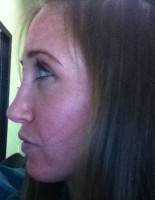Pixie Nose
Pixie or upward pointing noses were all the rage in the ’80s. This trend has changed to make noses more natural and soft.
Earlier rhinoplasty procedures really created a over-operated appearance. The first thing to do is to carefully analyze your face. The size of your face, the skin texture, the patient’s height.
All of these variables affect the overall proportion of the nose with respect to the face and body. Shorter, petite females can carry of a more petite, upturned nose.
Patients who are taller or who have larger features need a more substantial nose. The primary goal in rhinoplasty is matching the correct nasal proportions to the patient.
A good rhimnoplasty surgeon should do a complete history/physical, analyze the nose, examine the nose, examine the internal portion of the nose, take pictures, and do a complete photo imaging so that the patient and the doctor can both communicate their individual aesthetic sense to each other. (Raghu Athre, MD, Houston Facial Plastic Surgeon)
There are obviously many good points that have been brought up here, and it can get a bit confusing. I don’t think that you should be worrying about counter-rotating or deprojecting and that this is just too much info.
Just know that this can definitely be corrected and that the surgeon will likely need to add cartilage (which they will borrow from your septum, ear, or rib!) to “build up” your nose. Look for someone experienced in rhinoplasty. You generally won’t find a “pixie nose” specialist, but look for pictures of previous patients with similar noses. (Ryan N. Heffelfinger, MD, Philadelphia Facial Plastic Surgeon)
How to treat a pixie nose?
Depending on where you live and the experience of the surgeons in your area you should visit with a few either Facial Plastic Surgeons Or Plastic Surgeons who specialize in nose surgery. A well trained surgeon who performs many nasal surgeries per year should be able to help you. If you can pick a surgeon who can image you on a computer, that might help you determine what you would like to have done. (Carlos Wolf, MD, Miami Facial Plastic Surgeon)
Choosing an rhinoplasty surgeon for pixie nose
Choosing the right rhinoplasty surgeon is important. I would focus on a surgeon who is a specialist in your ethnic characteristics and who can design a nasal surgery specific to your desires. (Raffy Karamanoukian, MD, FACS, Los Angeles Plastic Surgeon)
Pixie Nose
Rhinoplasty is one of the most challenging operations we do and therefore a nose job is never “just a nose job”. Pick a surgeon who does a lot of rhinoplasties.
Your procedure will be difficult because it will be necessary to de – rotate or lengthen your nose. I strongly suggest you have an experienced rhinoplasty surgeon. (Richard W. Fleming, MD, Beverly Hills Facial Plastic Surgeon)
Difficult Rhinoplasty
The description you are giving of your nose is “pixie”, and “stuck up”, conjuring up an image of a small nose with an upwardly rotated tip. I am assuming that the changes you would ike to have relate to a relative lengthening or de-rotation of the nasal tip. This is actually a very difficult result to achieve in Rhinoplasty, requiring cartilage extension grafts.
This is not, “just a nose job” and requires a Surgeon very experienced in Rhinoplasty to address your concerns. (Stephen Prendiville, MD, Fort Myers Facial Plastic Surgeon)
Seek a rhinoplasty specialist for your procedure
Since rhinoplasty can be one of the most complicated procedures in plastic surgery, it is recommended that you seek a specialist in that procedure. In your consultation you should ask your doctor if he performs the procedure frequently and see as many before and after pictures as you can to be comfortable that he/she can help you achieve the results you are looking for. Having realiatic expectations is also very important. A rhinoplasty specialist will help you understand what you can and cannot expect from surgery on your nose. (Jacob D. Steiger, MD, Boca Raton Facial Plastic Surgeon)
The truth about nose surgery
All nose jobs are NOT created equal. Your surgeon should have specialty training in rhinoplasty- this will most likely be a facial plastic surgeon or plastic surgeon. You must visit with the doctor, review your goals, and look at many b/a photos of patients with SIMILAR noses to yours. You’ll know when you’ve met the right physician. If I met with you I’d like to start with some additional information:
- Your age
- Whose nose do you like the most (celebs, etc)
- In your mind, what specifically would make your nose more aesthetic
- Height, weight, overall facial structure, personality, and ethnicity
- Are your issues simply cosmetic or do you have breathing/sinus issues also?
- Are you in search of perfection or improvement? (Ramtin Kassir, MD, Wayne Facial Plastic Surgeon)
Rhinoplasty requires an expert
I truly believe that rhinoplasty is one of the most complicated cosmetic operations we do. It is very important that you see someone who is experienced.
This is especially true because when you have a “pixie” nose the operation to lengthen and de-rotate the nose is even more complex.
Make sure that the surgeons you interview do at least 50 of these operations a year. Furthermore, make sure that you see their before and after photos. Make sure you see examples of noses just like yours (Benjamin C. Marcus, MD, Madison Facial Plastic Surgeon)
Rhinoplasty for pixie nose
A pixie nose can indeed be very cute, or maybe it is too upturned and you think it will look better if it was changed some.
I would go and consult several rhinoplasty specialists. Usually we do computer imaging at the consultation which will be helpful for you to preview the potential changes and decide whether this is something you like.
One thing to keep in mind for you: it is much more difficult to change the shape of the pixie, or really small upturned nose, than to do a more common reduction rhinoplasty.
It is a lot harder to make the nose bigger than to make it smaller. Make sure your surgeon is experienced, and ask for before and after photos of noses similar to yours. (Stella Desyatnikova, MD, Seattle Facial Plastic Surgeon)
Nose job requires a rhinoplasty specialist.
Every nose is different, and so every rhinoplasty requires a different approach. Your “pixie” nose is not a particular problem.
Every nose requires an expert 1) to come up with the right plan for your anatomy, and 2) to do the operation right. (George J. Beraka, MD (retired), Manhattan Plastic Surgeon)
A nose job is a hard operation
A “Nose Job” which is commonly known as a Rhinoplasty is one of most difficult operations we do in Plastic Surgery. It is indeed a surgery of millimeters as the difference between a good and bad result is often 1-2 millimeters.
Therefore, please make sure that you find a Board- Certified Plastic Surgeon who specializes in Rhinoplasty to correct your Pixie Nose as this even a more difficult variant of rhinoplasty.
The key elements are to make sure your Rhinoplasty Surgeon carefully analyzes your nose and discusses the options with you in detail (Rod J. Rohrich, MD, Dallas Plastic Surgeon)
Many plastic surgeon will be comfortable with your rhinoplasty
Nasal shape is one of the most individual features of the face, and changing the shape of the nose can be performed in so many ways. It’s important to remember are that a change in one aspect of the nose- the dorsum, the tip, the base, etc. can have a significant effect on how the rest of the nose is perceived.
Your “pixie” nose is one type of form that patients sometimes request- some women with the type of nose you want will ask for theirs to be changed. The nasal form that people feel is attractive is as individualized as the noses themselves. You should not feel bad about wanting some information about your options. Many plastic surgeons perform rhinoplasty, and some are more comfortable with this operation than others.
You will want to find a board certified plastic surgeon who you feel understands your goals, and seems comfortable with achieving them. It sounds as if you will want your nose lengthened and the tip rotated inferior- this will likely require both manipulation of the cartilage that you have, as well as some grafting of cartilage. These are techniques that are used routinely in rhinoplasty. Ask around for a surgeon who as operated on noses of some of the people you know- that’s always a great place to start! (Adam David Lowenstein, MD, FACS, Santa Barbara Plastic Surgeon)



